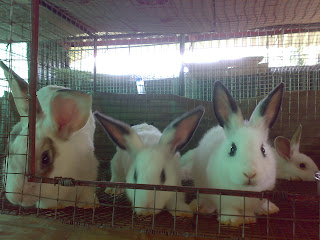These are the pictures of the Original stock of Cinnamon doe with her 4th litter as shown in the picture below. She gave birth to her 4th litter with 6 healthy kits on April 24, 2012. Her kits are still with her in the same cage as of this writing because I am running out of cages! When I first started raising these rabbits, I could not wait for them to grow up and start breeding. Now that they are breeding, I am getting overwhelmed with rabbits! They really multiply so fast and it's a good thing that I had the cages built and ready before I even started raising these original stocks of rabbits. Their cages are 2.5 feet wide by 3 feet long so there is enough space for the doe and her kits. I will be harvesting some meat rabbits on the first week of July so that will give me some empty cages and I could transfer these litters from their mothers. The kits are almost 2 months old in this picture below. I plan on giving these two original Cinnamon and Chinchilla does a rest from breeding to give them a chance to recuperate from all the kindling that they've been through for four consecutive breeding season. Maybe a month of rest from breeding will do them good so they could regain back their strength and stamina.
 |
| Original Cinnamon breeding stock at the back with her 4th litter. |
 |
| Original stock of Cinnamon breed |
The pictures below are that of my original stock of Chinchilla doe and her 4th litter. When we placed the Chinchilla doe inside the Chinchilla buck's cage to be bred, she was very eager and ready to mate but the buck was not! He must have gotten tired because we used him first to mate with the Cinnamon. It was really funny and comical to watch them because the doe was humping the head of the buck and the latter was all hunched down cowering in the corner. He played the role of "hard-to-get" until the doe got tired and settled down somewhat and then the buck was able to do his deed. Anyway, she kindled 5 healthy kits on April 23, 2012. Unfortunately, one of the kits of the Chinchilla was found in the gutter one morning. The kit must have been clinging to her mother's teat when the doe hopped out of her nest box after nursing her pups and the kit was carried along with her. There is no other way for the kit to have crawled out of its nest box at that time because the litter were not even a week old at that time. When the doe nurses her kits, she does not lie on her side like what dogs and cats usually do but rather, she sits and kinda leans forward a little while her kits feed on her teats. Anyway, there are only 4 kits living with their mother now in the same cage until I could transfer them in their own cage.







%5B1%5D.JPG)









